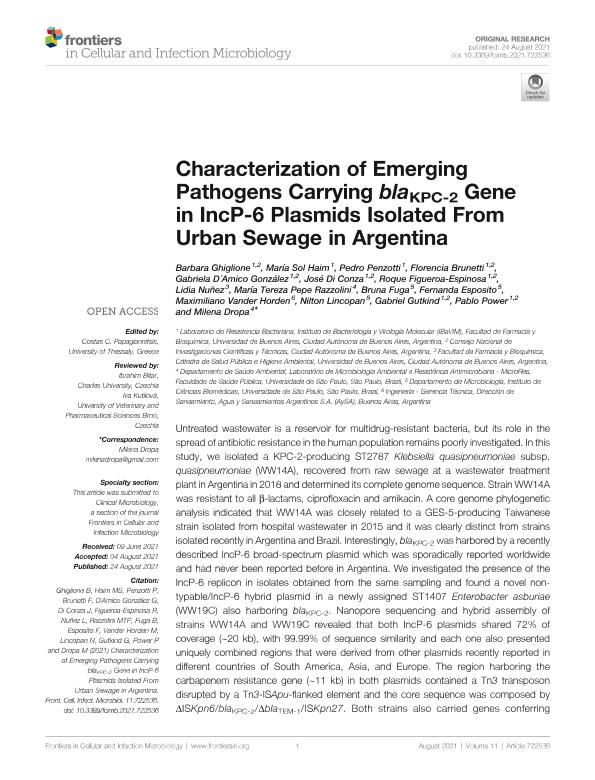Artículo
Characterization of Emerging Pathogens Carrying bla KPC-2 Gene in IncP-6 Plasmids Isolated From Urban Sewage in Argentina
Ghiglione, Barbara ; Haim, María Sol; Penzotti, Pedro; Brunetti, Florencia Lourdes
; Haim, María Sol; Penzotti, Pedro; Brunetti, Florencia Lourdes ; D'amico González, Gabriela Elena Noemí
; D'amico González, Gabriela Elena Noemí ; Di Conza, José Alejandro
; Di Conza, José Alejandro ; Figueroa Espinosa, Roque Arnulfo
; Figueroa Espinosa, Roque Arnulfo ; Nuñez, Fflidia; Pepe Razzolini, María Tereza; Fuga, Bruna; Esposito, Maria Fernanda; Vander Horden, Maximiliano; Lincopan, Nilton; Gutkind, Gabriel Osvaldo
; Nuñez, Fflidia; Pepe Razzolini, María Tereza; Fuga, Bruna; Esposito, Maria Fernanda; Vander Horden, Maximiliano; Lincopan, Nilton; Gutkind, Gabriel Osvaldo ; Power, Pablo
; Power, Pablo ; Dropa, Milena
; Dropa, Milena
 ; Haim, María Sol; Penzotti, Pedro; Brunetti, Florencia Lourdes
; Haim, María Sol; Penzotti, Pedro; Brunetti, Florencia Lourdes ; D'amico González, Gabriela Elena Noemí
; D'amico González, Gabriela Elena Noemí ; Di Conza, José Alejandro
; Di Conza, José Alejandro ; Figueroa Espinosa, Roque Arnulfo
; Figueroa Espinosa, Roque Arnulfo ; Nuñez, Fflidia; Pepe Razzolini, María Tereza; Fuga, Bruna; Esposito, Maria Fernanda; Vander Horden, Maximiliano; Lincopan, Nilton; Gutkind, Gabriel Osvaldo
; Nuñez, Fflidia; Pepe Razzolini, María Tereza; Fuga, Bruna; Esposito, Maria Fernanda; Vander Horden, Maximiliano; Lincopan, Nilton; Gutkind, Gabriel Osvaldo ; Power, Pablo
; Power, Pablo ; Dropa, Milena
; Dropa, Milena
Fecha de publicación:
08/2021
Editorial:
Frontiers Media
Revista:
Frontiers in Cellular and Infection Microbiology
ISSN:
2235-2988
Idioma:
Inglés
Tipo de recurso:
Artículo publicado
Clasificación temática:
Resumen
Untreated wastewater is a reservoir for multidrug-resistant bacteria, but its role in the spread of antibiotic resistance in the human population remains poorly investigated. In this study, we isolated a KPC-2-producing ST2787 Klebsiella quasipneumoniae subsp. quasipneumoniae (WW14A), recovered from raw sewage at a wastewater treatment plant in Argentina in 2018 and determined its complete genome sequence. Strain WW14A was resistant to all β-lactams, ciprofloxacin and amikacin. A core genome phylogenetic analysis indicated that WW14A was closely related to a GES-5-producing Taiwanese strain isolated from hospital wastewater in 2015 and it was clearly distinct from strains isolated recently in Argentina and Brazil. Interestingly, blaKPC-2 was harbored by a recently described IncP-6 broad-spectrum plasmid which was sporadically reported worldwide and had never been reported before in Argentina. We investigated the presence of the IncP-6 replicon in isolates obtained from the same sampling and found a novel non-typable/IncP-6 hybrid plasmid in a newly assigned ST1407 Enterobacter asburiae (WW19C) also harboring blaKPC-2. Nanopore sequencing and hybrid assembly of strains WW14A and WW19C revealed that both IncP-6 plasmids shared 72% of coverage (~20 kb), with 99.99% of sequence similarity and each one also presented uniquely combined regions that were derived from other plasmids recently reported in different countries of South America, Asia, and Europe. The region harboring the carbapenem resistance gene (~11 kb) in both plasmids contained a Tn3 transposon disrupted by a Tn3-ISApu-flanked element and the core sequence was composed by ΔISKpn6/blaKPC-2/ΔblaTEM-1/ISKpn27. Both strains also carried genes conferring resistance to heavy metals (e.g., arsenic, mercury, lead, cadmium, copper), pesticides (e.g., glyphosate), disinfectants, and several virulence-related genes, posing a potential pathogenic risk in the case of infections. This is the first study documenting blaKPC-2 associated with IncP-6 plasmids in K. quasipneumoniae and Enterobacter cloacae complex from wastewater in Argentina and highlights the circulation of IncP-6 plasmids as potential reservoirs of blaKPC-2 in the environment.
Palabras clave:
KLEBSIELLA QUASIPNEUMONIAE
,
ENTEROBACTER ABSURIAE
,
KPC-2
,
INCP-6
Archivos asociados
Licencia
Identificadores
Colecciones
Articulos(OCA HOUSSAY)
Articulos de OFICINA DE COORDINACION ADMINISTRATIVA HOUSSAY
Articulos de OFICINA DE COORDINACION ADMINISTRATIVA HOUSSAY
Citación
Ghiglione, Barbara; Haim, María Sol; Penzotti, Pedro; Brunetti, Florencia Lourdes; D'amico González, Gabriela Elena Noemí; et al.; Characterization of Emerging Pathogens Carrying bla KPC-2 Gene in IncP-6 Plasmids Isolated From Urban Sewage in Argentina; Frontiers Media; Frontiers in Cellular and Infection Microbiology; 11; 8-2021; 1-12
Compartir
Altmétricas



